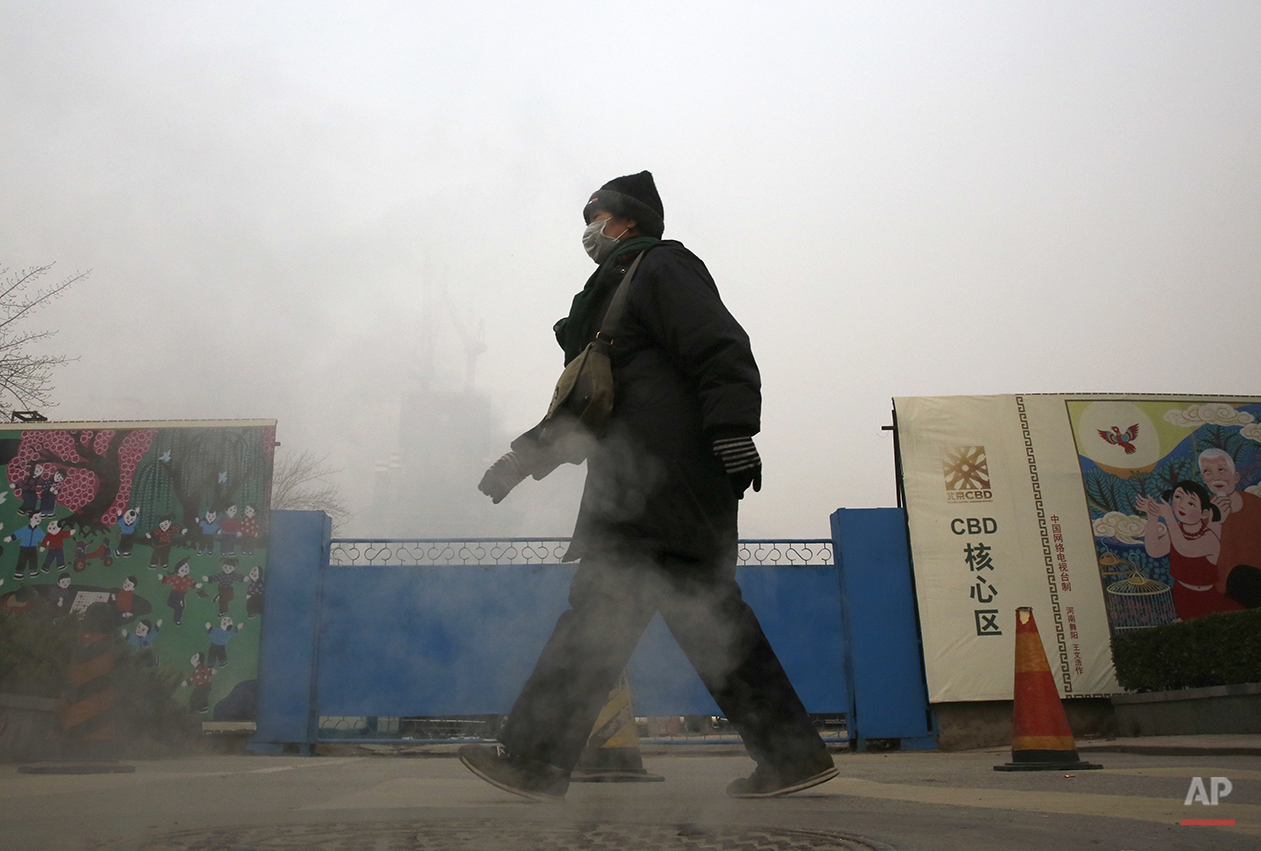Beijing issues first smog red alert

Schools closed and rush-hour roads were much quieter than normal as Beijing invoked its first-ever red alert for smog Tuesday, closing many factories and imposing restrictions to keep half the city's vehicles off the roads.
The alert in effect through Thursday — the most serious warning on a four-tier system adopted in 2013 — means authorities have forecast three consecutive days of severe smog.
Despite some improvement in Beijing's air over the past year, readings of dangerous particles Tuesday were as high as a dozen times the safe level, in what has become an embarrassment for a government that has made a priority of cleaning up the legacy of pollution left from years of full-tilt economic growth.
A grey soupy haze subsumed Beijing's unique landmarks, and convenience stores did brisker-than-usual business selling air-filtering masks as residents sought to spend as little time outdoors as possible.
"This is modern life for Beijing people. We wanted to develop, and now we pay the price," Beijing office worker Cao Yong said during a break from work.
Under the alert, schools were advised to voluntarily close unless they had good air filtration systems. However, Beijing's education commission later issued a separate order for all schools to close through Thursday.
Readings of PM2.5 particles climbed above 300 micrograms per cubic meter in some parts of the city Tuesday and were expected to continue rising before the air begins to improve with the arrival of a cold front on Thursday. The World Health Organization designates the safe level for the tiny, poisonous particles at 25.
"You have to do whatever you can to protect yourself," Beijing resident Li Huiwen said while stopping at a market. "Even when wearing the mask, I feel uncomfortable and don't have any energy."
Along with limiting cars to driving every other day depending on the last number of their license plate, a raft of other restrictions will seek to reduce the amount of dust and other particulate matter in the city of 22.5 million people. Officials said extra subway trains and buses would be added to handle the additional strain on public transport.
It's the second time this month that notoriously polluted Beijing has experienced a prolonged bout of smog, sending PM2.5 levels in the suburbs as high as 976 micrograms. Beijing was also shrouded in persistent smog for most of November, when power demand soared due to unusually cold weather.
While pollution in the capital improved in the first 10 months of the year compared with the same period last year, heavy smog that can be seen from outer space regularly forces Beijing schools to suspend outdoor activities and can even prompt highway closures because of reduced visibility.
"It is a sharp warning to us that we may have too much development at the price of environment and it is time for us to seriously deal with air pollution," said Fan Jinglong, a hotel employee.
There previously have been stretches of severe smog in Beijing that lasted more than three days. However, those had initially been forecast to last three days or less, so they did not trigger a red alert. The alert requires a forecast of 72 straight hours with pollution levels of 300 or higher on the city's air quality index.
The air quality index is very closely linked to levels of PM2.5, although it also takes into account other pollutants. For example, one monitoring site in Beijing that gave an index reading of 308 midday Tuesday also had a PM2.5 level of 258 micrograms per cubic meter.
Polluted air throughout broad swaths of China has had severe health effects. A study led by atmospheric chemist Jos Lelieveld of Germany's Max Planck Institute and published this year in Nature magazine estimated that 1.4 million people each year die prematurely because of pollution in China.
Most of the pollution is blamed on coal-fired power plants, along with vehicle emissions and construction and factory work. China, the world's biggest carbon emitter, plans to upgrade coal power plants over the next five years to tackle the problem, and says its emissions will peak by around 2030 before starting to decline.
While emissions standards have been tightened and heavy investments made in solar, wind and other renewable energy, China still depends on coal for more than 60 percent of its power.
See more photos on APImages.com
Text from the AP news story, Beijing Schools Close as City Issues 1st Smog Red Alert, by Christopher Bodeen.
Follow AP photographers on Twitter: http://twitter.com/AP/lists/ap-photographers
Spotlight is the blog of AP Images, the world’s largest collection of historical and contemporary photos. AP Images provides instant access to AP’s iconic photos and adds new content every minute of every day from every corner of the world, making it an essential source of photos and graphics for professional image buyers and commercial customers. Whether your needs are for editorial, commercial, or personal use, AP Images has the content and the expert sales team to fulfill your image requirements. Visit apimages.com to learn more.
Written content on this site is not created by the editorial department of AP, unless otherwise noted.
AP Images on Twitter | AP Images on Facebook | AP Images on Instagram


























